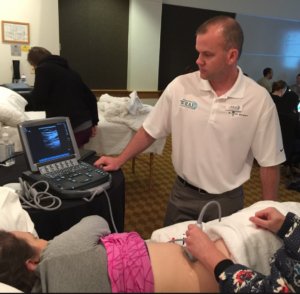Scott Urigel, MSN, CRNA, and Jeff Molter, MSN, CRNA, MBA, faced a challenge familiar to Certified Registered Nurse Anesthetists (CRNAs) everywhere: How to keep pace with rapidly evolving best practices in nurse anesthesiology. The business partners were teaching weekend courses on ultrasound-guided nerve blocks but wanted participants to leave with relevant, up-to-date lessons accessible at anytime. Their solution was the Block Buddy app to provide CRNAs with real-time information to assist them with their daily work and education.
“We were trying to find new ways to have this great content be available to CRNAs outside of the course,” says Urigel, who eventually bought out Molter. “Initially, we thought about an e-book but decided there had to be a better way to provide instructional information, and we started the process for building the app that would become Block Buddy.”
In 2019, Block Buddy evolved to become Block Buddy Pro, the ultimate resource for regional anesthesia education. The original app and Block Buddy Pro are part of Urigel’s commitment to improving the lives of patients and increasing the knowledge of CRNAs.
With Block Buddy Pro, CRNAs have a comprehensive suite of resources to help them overcome challenges in their practice and advance their knowledge of nerve blocks and regional anesthesia. To keep CRNAs on the cutting edge, Urigel regularly consults journal information and the latest research to update the app’s content with the best practices and emerging techniques in regional anesthesia and non-surgical pain management.
Reflecting the demands of CRNA schedules and workloads, the resources on Block Buddy Pro are accessible anytime, anywhere in a variety of formats. Descriptions of 38 nerve blocks, more than 80 narrated videos, lessons, demonstrations and hundreds of comprehensive medical illustrations and sonograms are available. Further content covers non-surgical pain management procedures including information about non-opioid medications, local anesthetics, and medications for patients who may be on anticoagulants or other blood-thinning medications.
“CRNAs who have used the blocks feature say this app helped them experience something they were not able to at this point in their career,” says Urigel, an AANA member since 1999. “This technology provides a visualization of nerve blocks that studying in textbooks couldn’t provide, and unlike a textbook, the content can be frequently updated.”

The educational information is practical and applies to the full spectrum of regional anesthesia practices, as well as point-of-care ultrasound (POCUS). This includes assessing gastric content in patients who may have delayed gastric emptying due to an underlying disease process or emergency situation. Urigel says CRNAs often consult this feature. Gastric scanning can be useful in determining if patients may have delays in gastric emptying that may increase the risk for pulmonary aspiration even when the patient followed the NPO or “Nothing By Mouth” guidelines. “Performing a gastric scan preoperatively in these patients may help identify those individuals who have a full stomach,” Urigel says.
Although all CRNAs can supplement their practice and elevate their patient care with the app, Urigel sees Block Buddy Pro as particularly beneficial for residents and rural practitioners.
Today’s residents can review resources on phones and tablets, something previous generations could not do. Using updated pinch-zoom capabilities, residents can clearly see ultrasound images on any screen size, providing details with precision and making it easier to refine techniques, increase proficiency and ensure safe patient care. Residents also can use the notes feature to add their thoughts on lessons they review.
“For resident nurse anesthesiologists, these features offer visuals that are incredibly instructive, and the reference images really help bring it all together as part of their educational processes,” Urigel says.
In areas lacking reliable mobile coverage, the app’s downloadable capabilities really shine. CRNAs practicing in those areas can download content onto mobile devices and access it whenever they want.
Looking to a future of continual improvement to app content and performance, Urigel recently turned over stewardship of the app to Rm8, the AANA innovation lab. Rm8 provides unique programs and initiatives to revolutionize how healthcare startups are nurtured, supported and connected. Drawing on a depth of experience, technologies and leadership, Rm8 is positioned to facilitate and accelerate growth and development of Block Buddy Pro. Together with AANA leadership and Urigel as a consultant, Rm8 will realize Urigel’s dream of making Block Buddy Pro readily available to the broader CRNA and healthcare community.
“Block Buddy Pro is part of AANA’s umbrella of services helping expand its mission of innovation to its members,“ Urigel says. “AANA is all about promoting our profession and giving its members the tools they need to function at the top of our skills and practice to full scope of our education.”
For more information about Block Buddy Pro, visit Block Buddy App | Ultrasound Guided Nerve Blocks (myblockbuddy.com)